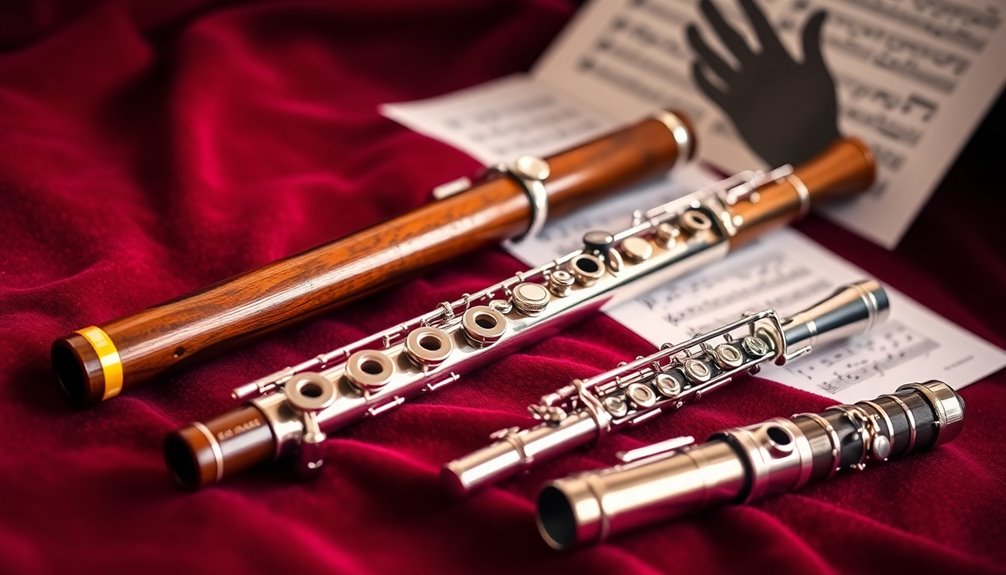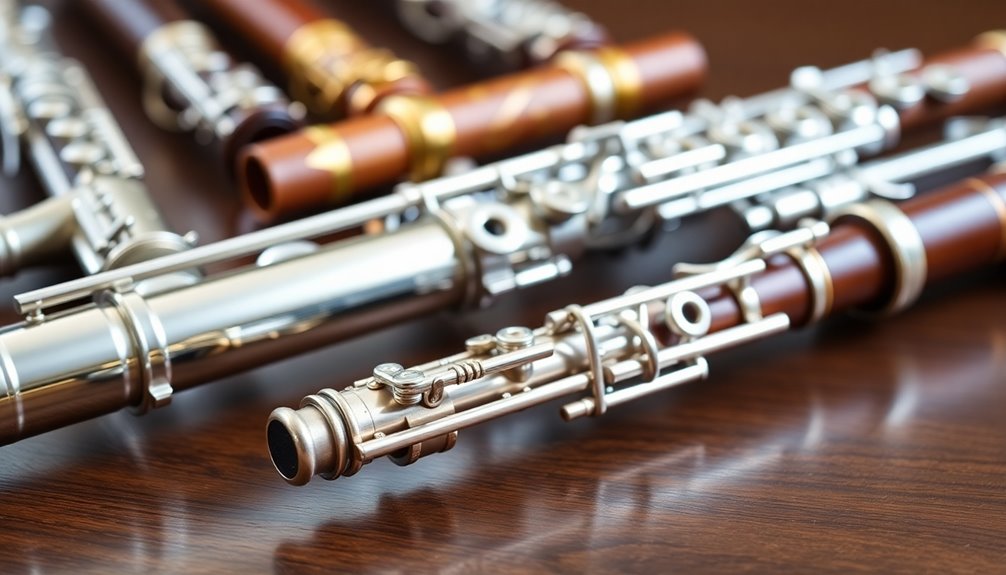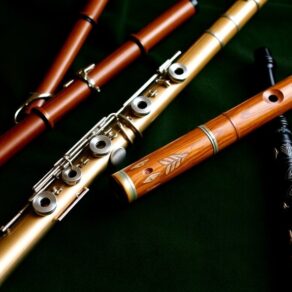When comparing flute types as a new player, consider your musical interests and comfort. The concert flute offers versatility and a rich tone, making it ideal for beginners. In contrast, the piccolo stands out with its bright sound, while the alto and bass flutes provide warm, soothing tones that complement other instruments. Wooden flutes deliver beautiful emotional resonance, and the Native American flute fosters cultural connection. For simplicity, a keyless flute helps beginners focus on techniques. Each type has unique attributes, guiding your choice based on your style and goals; exploring further will reveal even more options suited for you.
Key Takeaways
- The concert flute is versatile, with a rich tonal quality, making it a popular choice for beginners across various musical genres.
- Keyless flutes are beginner-friendly, focusing on fundamental techniques without complex key mechanisms, making them more accessible and affordable.
- Wooden flutes produce warm, resonant tones, but require unique playing techniques that may be challenging for new players.
- Piccolo flutes offer a bright timbre and high pitch, enhancing overall flute skills while providing opportunities for vibrant musical collaboration.
- Native American flutes are accessible for beginners, allowing for expressive melodies and fostering a connection to cultural traditions through simple finger placements.
Concert Flute

The allure of the concert flute lies in its versatility and rich tonal quality, making it an excellent choice for new players. As you commence on your musical journey, you'll find that the concert flute features a straight body, typically made of silver or a silver-plated alloy, which contributes to its warm sound and broad dynamic range.
Its key system is designed for ease of use, allowing beginners to produce clear notes with relative simplicity.
One of the significant advantages of the concert flute is its adaptability across various musical genres, from classical to contemporary. This means you can explore different styles, fostering a sense of belonging within diverse musical communities.
Additionally, the concert flute's lightweight design makes it comfortable for long practice sessions, helping you build endurance as you learn.
However, to fully appreciate your instrument, regular concert flute maintenance is essential. Cleaning your flute after each use prevents moisture buildup, which can damage pads and affect sound quality.
Utilize a cleaning rod and cloth to remove any residue, and periodically check for loose screws or pads that may need adjustment.
Investing time in maintenance not only guarantees your flute remains in top condition but also deepens your connection to the instrument. Moreover, maintaining your flute's material quality and safety will enhance its durability and performance over time.
As you master your skills, the concert flute will become more than just a tool; it'll be a trusted companion on your musical journey, inviting you into a world of harmony and expression.
Piccolo Flute

For those looking to explore more unique sounds, the piccolo flute offers a distinct and bright timbre that sets it apart from its larger counterpart, the concert flute. As a new player, you'll find that the piccolo can open doors to a wide range of musical styles and techniques, allowing you to express yourself in exciting ways.
- It's lightweight and portable, making it easy to carry for rehearsals and performances.
- The piccolo's high pitch cuts through orchestral textures, providing a vibrant accent.
- Learning piccolo techniques can enhance your overall flute skills, improving your breath control and finger dexterity.
- The piccolo repertoire is rich, featuring works from classical composers to contemporary pieces.
- You'll find opportunities to collaborate in various ensembles, fostering a sense of community.
When you start playing the piccolo, you'll need to adjust your approach. The fingerings are similar to the concert flute, but you'll need to develop specific piccolo techniques such as precise intonation and articulation.
Many piccolo players enjoy the challenge of mastering the instrument's agility, which is essential for executing rapid passages found in its repertoire. Additionally, the choice of high-grade materials can significantly enhance the piccolo's overall sound quality and durability.
Moreover, the piccolo can serve as a bridge to new musical experiences. Whether you're interested in orchestral playing or chamber music, the piccolo's unique voice will help you connect with fellow musicians.
Embracing the piccolo not only allows you to diversify your skills but also invites you into a vibrant community of musicians.
Alto Flute

Exploring the alto flute provides a rich, warm sound that complements its higher-pitched siblings. As a new player, you might find the alto flute's deeper timbre to be both inviting and rewarding. This instrument, tuned a fourth lower than the concert flute, offers unique alto flute benefits that can enhance your musical experience and versatility.
One notable advantage of playing the alto flute is its ability to blend beautifully in ensembles, particularly in chamber music settings. Its mellow tone adds depth, making it a favorite among composers for creating lush soundscapes. You'll notice that the alto flute's range allows you to explore different styles, from classical to contemporary, expanding your musical repertoire.
To fully harness the alto flute benefits, it's important to master various alto flute techniques. For instance, focusing on breath control and air support can greatly affect your sound quality. Additionally, practicing vibrato and dynamic control will enrich your playing, making your performances more expressive. Using a proper embouchure technique can significantly enhance your control over tone and dynamics.
Don't hesitate to experiment with different fingerings and embouchure adjustments to find what feels comfortable for you.
As you start on your journey with the alto flute, remember that community and connection are crucial. Engaging with fellow musicians can provide encouragement and valuable insights, helping you grow as a player. Embrace the challenge, and you'll discover the alto flute's charm and the joy it brings to your musical expression.
Bass Flute

Bass flutes offer a unique tonal palette that can greatly enhance your musical endeavors. If you're looking to expand your flute-playing experience, you'll find that the bass flute stands out with its rich, warm sound that resonates deeply.
Here are a few aspects to reflect on:
- Range: The bass flute typically has a range that extends down to C, providing a beautiful lower register.
- Techniques: Mastering bass flute techniques, such as breath control and finger agility, can open up new expressive possibilities.
- Repertoire: There's a growing body of bass flute repertoire that includes both solo and ensemble works, making it an exciting addition to your practice.
- Collaboration: The bass flute blends well with other instruments, allowing you to explore collaborative opportunities in chamber music settings.
- Learning Curve: While it may take some time to adapt to the instrument's size and weight, the rewards of playing are well worth the effort.
As you immerse yourself in bass flute techniques, you'll discover a world of musical expression that complements your existing skills. Additionally, the bass flute's versatility across genres makes it a valuable instrument for exploring various musical styles.
The instrument's unique qualities can inspire you to explore new compositions and styles, enriching your overall musicianship.
Whether you're performing in small ensembles or simply enjoying solo practice, the bass flute offers a sense of belonging within a community of fellow musicians.
Embrace this opportunity, and you'll find that the bass flute can become a cherished part of your musical journey.
Wooden Flute

While the bass flute offers a rich, deep sound, the wooden flute brings its own distinct character to the table. This flute type is known for its warm, resonant tone quality, which can evoke a range of emotions, making it a favorite among many musicians. If you're reflecting on a wooden flute, you'll appreciate its ability to produce a rich, vibrant sound that can fill a room with melody.
One of the key aspects to evaluate with wooden flutes is their unique playing techniques. Unlike metal flutes, wooden flutes often require a slightly different approach to breath control and finger positioning. You'll find that the tone can vary greatly based on your embouchure, or the way you shape your mouth around the mouthpiece. This means practice is essential; the more you play, the more you'll discover the nuances of sound production.
Additionally, wooden flutes are often crafted with different types of wood, each influencing the instrument's tone quality. For instance, flutes made from boxwood produce a softer, warmer sound, while those made from grenadilla offer a brighter, more focused tone. Understanding these variations can help you choose the right flute for your personal style. Moreover, the choice of wood not only affects the tone but also contributes to the flute's overall sound quality, which is crucial for achieving the desired musical expression.
Native American Flute

The Native American flute stands out as an enchanting instrument with a rich cultural heritage and a unique sound that resonates deeply with players and listeners alike. As you explore this flute, you'll discover its vibrant history and the emotional connection it fosters. Here are some key aspects to reflect on:
- Cultural significance: Originating from various Native American tribes, this flute embodies storytelling and spiritual expression.
- Unique sound: The soft, haunting melodies produced can evoke a range of emotions, making it perfect for meditation or relaxed gatherings.
- Playing techniques: You'll find that the Native American flute employs simple finger placements, which make it accessible to beginners, yet offers depth for advanced players.
- Materials: Traditionally carved from wood or bamboo, the materials influence tone and resonance, enhancing your playing experience.
- Community: Engaging with other players at workshops or online can help you feel connected to a larger tradition.
When you pick up a Native American flute, you're not just learning an instrument; you're participating in a cultural narrative. The playing techniques are designed to be intuitive, allowing you to express your emotions and connect with your surroundings. Additionally, the craftsmanship of each flute often reflects the importance of quality materials, which can significantly enhance the instrument's sound quality and durability.
As you probe deeper into this art form, you'll find that the flute serves as a bridge to both your inner self and the rich traditions of Native American culture. Embrace this journey, and let the melodies guide you toward a sense of belonging and fulfillment.
Baroque Flute

How does the Baroque flute transport you to a different era of music? This enchanting instrument, originating in the 17th and 18th centuries, invites you to explore a unique sound world characterized by its distinct tonal qualities and rich historical significance.
As a new player, embracing the Baroque flute can deepen your connection to the music of composers like Bach and Handel, whose works showcase the instrument's expressive capabilities. Unlike modern flutes, Baroque flutes are typically made of wood and have a smaller bore, which contributes to their warm, mellow sound.
You'll find that playing with Baroque techniques, such as ornamentation and varied vibrato, allows you to express the nuances of this style more authentically. These techniques not only enhance your playing but also immerse you in the historical context of the music, connecting you to the cultural practices of the time.
Moreover, the Baroque flute's historical significance lies in its role in the evolution of Western classical music. By choosing this flute, you're not just learning an instrument; you're participating in a tradition that has shaped musical expression for centuries. The Baroque flute is part of the larger family of flutes, which includes Western concert flute and other variations that enrich the musical landscape.
As you investigate the repertoire and performance practices of the Baroque era, you'll cultivate a sense of belonging within a vibrant community of musicians dedicated to preserving this beautiful art form. Embrace the Baroque flute, and you'll find yourself part of a legacy that transcends time.
Electronic Flute

Exploring the domain of modern flutes, the electronic flute stands out as a fascinating innovation that merges traditional flute techniques with cutting-edge technology. This instrument represents a significant leap in how you can approach music-making, especially for new players.
Its integration of digital flute technology reveals a world of possibilities that can enhance your learning experience.
Here are some benefits of electronic flutes that you might find appealing:
- Built-in Recording: Capture your practice sessions and track your progress.
- Sound Modulation: Experiment with various sounds and effects, expanding your musical palette.
- Volume Control: Play quietly or amplify your sound, making it perfect for practice at home.
- Learning Aids: Many electronic flutes come with built-in metronomes and tuners to support your development.
- Portability: Lightweight and easy to transport, making practice more convenient anywhere.
As you explore the electronic flute, you'll discover that it caters to both traditionalists and tech enthusiasts alike. Additionally, investing in essential flute practice tools can further enhance your learning experience.
The benefits of electronic instruments can ease the learning curve, allowing you to focus on technique while enjoying the flexibility that digital features provide.
Whether you're jamming with friends or performing solo, the electronic flute gives you the tools to express yourself without the limitations of conventional instruments.
Embracing this innovative flute could be the key to revealing your musical potential, blending classic artistry with modern convenience.
Keyless Flute

Keyless flutes are increasingly popular among new players, offering a unique approach to mastering flute music. These flutes, which lack the complex key mechanisms of their keyed counterparts, allow you to focus on fundamental techniques and sound production. This simplicity can foster a strong foundational understanding of flute playing.
One of the keyless flute benefits is its lightweight design, making it easier to handle for beginners. You'll find that without keys, the instrument feels more natural, enabling you to develop your finger dexterity and hand coordination. Additionally, keyless flutes often come at a more affordable price point, making them accessible for many aspiring musicians.
To help you grasp the advantages of keyless flutes, here's a quick comparison of features:
| Feature | Keyless Flute |
|---|---|
| Weight | Lightweight |
| Complexity | Simple to play |
| Price | Generally lower |
| Maintenance | Easier upkeep |
When it comes to mastering keyless flute techniques, focus on breath control and finger placements. Since you won't have to navigate through multiple keys, you can concentrate on developing a rich tone and accurate intonation. Additionally, closed-hole key systems are recommended for beginners, which can further enhance your learning experience.
Frequently Asked Questions
What Is the Best Flute Type for Complete Beginners?
When you're starting your flute journey, you'll want a beginner flute with features that support your learning.
Look for a student flute that has a closed hole design, as it's easier to play. Additionally, lightweight materials can make it more comfortable for long practice sessions.
Brands like Yamaha and Gemeinhardt often come highly recommended for their durability and sound quality.
Choosing the right flute can enhance your experience and boost your confidence as you learn.
How Much Should I Budget for a Beginner Flute?
When budgeting for a beginner flute, you should consider flute pricing that typically ranges from $100 to $500.
If you're on a tight budget, aim for an instrument on the lower end, but make certain it's still of decent quality.
Don't forget to factor in additional costs like maintenance and accessories.
Investing wisely now can enhance your learning experience and help you feel more connected to your musical journey.
Can I Play Different Flute Types With One Embouchure?
You might think it's impossible to play different flute types with one embouchure, but it's totally doable!
With a bit of embouchure adaptation, you can enjoy the versatility that various flutes offer. While each flute has its nuances, your foundational skills can transfer across instruments.
What Maintenance Do Flutes Require for Longevity?
To guarantee your flute lasts, regular maintenance is key.
Start with flute cleaning after each session; use a soft cloth to wipe down the body and remove moisture.
Don't forget about pad care; guarantee pads stay dry to prevent damage.
Avoid excessive pressure on the keys and store your flute in a protective case.
Are There Flute-Specific Lessons Available for New Players?
Absolutely, there are flute-specific lessons available for new players!
You'll find numerous beginner resources, both online and in-person, tailored to help you get started. These lessons focus on fundamental techniques, proper finger positioning, and breathing exercises, making it easier for you to grasp the basics.
Joining a community or group can also enhance your learning experience, connecting you with fellow beginners who share your passion for playing the flute.
Conclusion
Choosing the right flute type can feel like searching for a needle in a haystack, but understanding your options helps. Each flute offers unique characteristics that cater to different playing styles and musical preferences. Whether you're drawn to the bright sound of the concert flute or the earthy tones of the Native American flute, picking the right one will enhance your learning experience. Take your time, explore, and soon you'll find the perfect fit for your musical journey.






